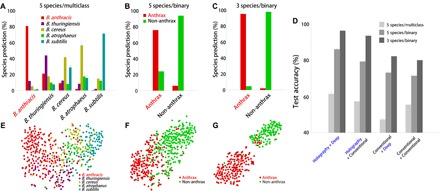Fig. 3. Performance of HoloConvNet.

(A to C) The test images are used to measure the performance of (A) multiclass classification of the five Bacillus species (B. anthracis, B. thuringiensis, B. cereus, B. atrophaeus, and B. subtilis), (B) binary classification of B. anthracis and the other four species (B. thuringiensis, B. cereus, B. atrophaeus, and B. subtilis), and (C) binary classification of B. anthracis and the two nonmember species of the B. cereus group (B. atrophaeus and B. subtilis). (D) The performance of the proposed method is compared to previous techniques (see the main text). Holographic microscopy and deep learning significantly improve the performance in all cases. (E to G) t-SNE visualization of the CNN codes at the last hidden layer, corresponding to the classification schemes of (A) to (C), which shows the representation learning capability of HoloConvNet. The error bars in (A) to (D) indicate the SD calculated from 10 classification models with different random initializations.
